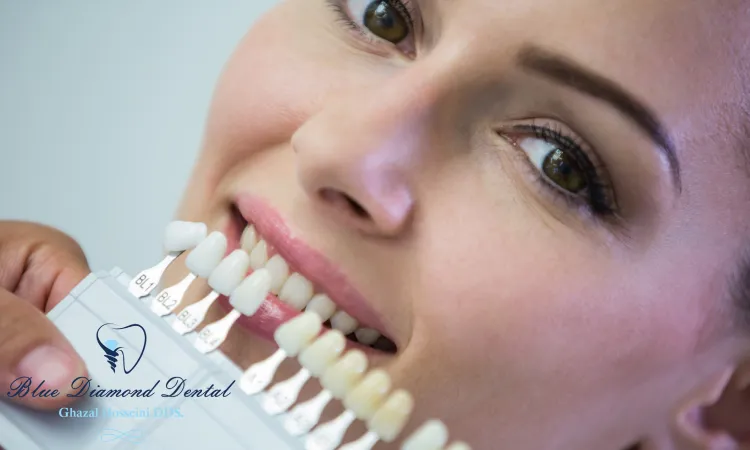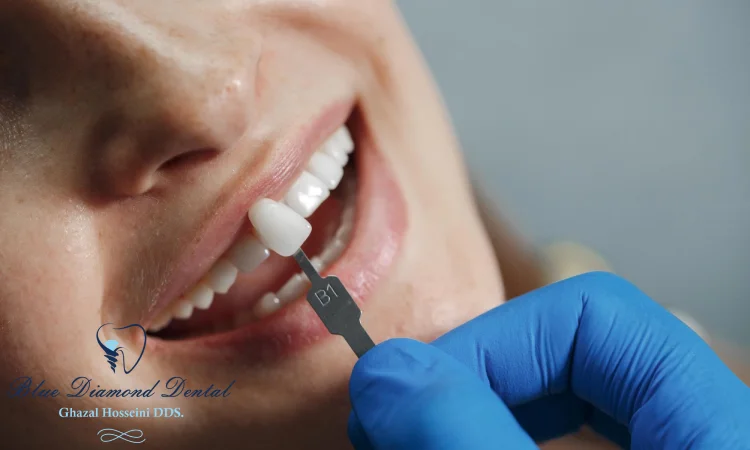- Home
- Services in Blue Diamond Dental

Orthodontics

Pediatric Dentistry
Dental Space Maintainers
Fluoride Treatment
Dental Pulp Treatment
Dental Sealants
Dental Fillings

Cleaning & Prevention

Surgical Dentistry
Tooth extraction
Tooth Extraction Membrane Fell Out
Surgical Placement
Dental bone graft - Contact Us
- About Us
porcelain dental bridge
A porcelain dental bridge is a popular restorative dentistry treatment that effectively replaces one or more missing teeth. It consists of two dental crowns on either side of the gap, which serve as anchors, and a pontic (replacement tooth) in between. Porcelain is the material for dental bridges due to its superb aesthetics and durability.
Don’t let the constant discomfort of missing teeth and difficulty in chewing hold you back any longer. Take control of your dental health today with our advanced dental porcelain Bridge in BLUE DIAMOND DENTAL, precision-crafted to restore your smile and improve functionality. Don’t delay any further – schedule a consultation now to experience the life-changing transformation that awaits you.
What is a porcelain dental bridge?

One key advantage of porcelain dental bridges is their ability to blend seamlessly with natural teeth. The porcelain material can be color-matched to the surrounding teeth, ensuring a harmonious smile. This aesthetic benefit can significantly improve one’s self-confidence and overall appearance.
Moreover, porcelain bridges are renowned for their durability and longevity. With proper care and maintenance, they can last for many years without the need for replacement. Unlike metal or resin, porcelain does not rust or stain over time.
To conclude, a porcelain dental bridge offers numerous benefits over alternative treatments for restoring missing teeth. Its exceptional aesthetics allow for a natural-looking smile, while its sturdy construction provides long-term functionality. As technology advances in dentistry continue to enhance the performance of these restorations, patients can trust that their smiles will remain bright and beautiful with the help of porcelain dental bridges.
Is porcelain suitable for dental bridges?
Dentists often recommend porcelain due to its ability to mimic teeth’ natural color and clarity, ensuring a seamless blend with the patient’s existing dentition. This not only helps in boosting the individual’s self-esteem but also contributes to a more natural-looking smile.

Another advantage of porcelain dental bridges is their durability. Porcelain is solid and resistant to chipping or cracking, making it an ideal choice for long-term use. Unlike other materials, such as metal or acrylic, porcelain maintains strength even when exposed to everyday chewing forces. Moreover, this material is highly biocompatible, which means it does not cause any adverse reactions within the mouth.
Additionally, technological advances have allowed for the creation of all-porcelain bridges without the need for metal substructures. This eliminates concerns regarding allergenic reactions or unsightly dark lines around gum margins that were once associated with traditional bridgework. Patients can now enjoy the benefits of both functionality and aesthetics with state-of-the-art all-porcelain dental bridges.
In conclusion, choosing porcelain as a material for your dental bridge offers numerous advantages over other options. Not only does it provide exceptional strength and durability, but it also ensures a more natural appearance by closely resembling your existing teeth. With advancements in technology, all-porcelain bridges offer optimal aesthetics without compromising functionality.
Types of Dental Bridges
When it comes to dental bridges, one of the most popular options is the dental porcelain bridge. Made from high-quality porcelain material, this type of bridge offers a natural-looking appearance that closely resembles natural teeth. The porcelain used in these bridges is durable and stain-resistant, making it an ideal choice for those seeking a long-lasting solution. Another advantage is its ability to blend well with the surrounding teeth, creating a seamless and aesthetically pleasing result.

Another type of dental bridge worth considering is the cantilever bridge. This design differs from traditional bridges by using only one adjacent tooth to support the restoration instead of two. This makes it particularly useful in situations where no adjacent teeth are available for support or when they are deemed unsuitable for various reasons. The success of a cantilever bridge relies heavily on proper planning and assessment by an experienced dentist to ensure a stable and functional restoration.
Maryland Bridges may be an excellent choice for those who prefer more conservative treatment options. These bridges use a metal or porcelain framework bonded onto the back surfaces of adjacent teeth with special resin cement. Unlike traditional bridges requiring extensive preparation of neighboring teeth, Maryland bridges offer a less invasive approach, preserving most of the healthy tooth structure while providing adequate tooth replacement.
In conclusion, dental porcelain bridges provide natural aesthetics and durability, while cantilever and Maryland bridges offer alternate approaches for specific cases.
When to do dental bridges?
Dental bridges are often recommended when a patient has one or multiple missing teeth. These restorations offer a practical and aesthetically pleasing solution to restore function and appearance to the patient’s smile. Dental porcelain bridges, in particular, are famous due to their durability and natural appearance.
One of the critical factors determining the optimal timing for getting dental bridges is the stability of the surrounding teeth. These neighboring teeth must be healthy and robust enough to support the bridge, as they serve as anchors for the restoration. Therefore, if there are any signs of decay or gum disease in these teeth, it is essential to address these issues before proceeding with a bridge.
Another important consideration is related to bone health. When a tooth is lost, the underlying jawbone can start deteriorating over time due to insufficient stimulation from chewing forces. This can lead to bone loss and compromise future options for tooth replacement. Getting dental bridges sooner rather than later helps prevent further bone deterioration by restoring proper function and maintaining healthy stimulation at the site of missing teeth.
In conclusion, it is generally advisable to avoid getting dental bridges once a tooth or multiple teeth are lost. Prompt action ensures better outcomes and prevents potential complications that may arise from waiting too long.
How long do porcelain bridges last?
The lifespan of a porcelain bridge depends on various factors, including oral hygiene practices, eating habits, and the individual’s overall health. On average, a well-maintained porcelain bridge can last 10 to 15 years or even longer. However, it’s important to note that no dental restoration is permanent and may require replacement or repair over time.
Proper oral hygiene is crucial to extend your porcelain bridge’s longevity. Regular brushing and flossing keep your teeth clean and prevent bacteria buildup around the bridge edges. Additionally, avoiding habits such as biting on complex objects or opening packages with your teeth can help minimize stress on the bridge structure.
Overall, while there is no definitive answer to how long a porcelain bridge will last in every case, taking care of your oral health and maintaining good dental hygiene practices can significantly extend its lifespan. Regular check-ups with your dentist will allow early detection of any issues that may arise and increase the chances of preserving your beautiful smile for years.
Which is better, plastic or porcelain fixed bridge?
Plastic or composite bridges are made from a durable resin material that can be color-matched to your natural teeth. This makes them an excellent choice for those seeking a seamless and aesthetically pleasing result. Additionally, plastic bridges are typically less expensive than porcelain alternatives, making them more accessible for patients on a budget.
On the other hand, dental porcelain is renowned for its durability and ability to mimic natural teeth’ appearance closely. Porcelain fixed bridges offer superior strength and are less prone to staining or discoloration over time than their plastic counterparts. Furthermore, porcelain bridges have a smoother surface that prevents plaque buildup, promoting better oral hygiene overall. While they may come at a higher cost initially, the long-term benefits make them worth considering for those who prioritize longevity and aesthetics.
Choosing between plastic or porcelain fixed bridges depends on budget constraints and personal preferences. It’s crucial to consult with your dentist about your individual needs and expectations before deciding.
Cost of Dental porcelain Bridge
The price varies depending on several factors, such as the number of teeth being replaced, the complexity of the case, and the location where the dental treatment is sought. It’s important to note that while all-porcelain bridges tend to be pricier than their alternatives, they offer superior aesthetics and natural-looking results.

When considering the cost of all-porcelain bridges, it’s essential to understand that this investment goes beyond just a simple cosmetic enhancement. A well-crafted bridge can substantially improve an individual’s ability to chew and speak correctly, ultimately enhancing their overall quality of life. Moreover, with proper care and maintenance, these bridges can last for many years, making them a valuable long-term investment in one’s oral health.
While it may be tempting to opt for cheaper options to save money upfront, it is crucial to consult with a qualified dentist specializing in cosmetic dentistry. They will ensure that your desired outcome aligns with your budget while providing peace of mind regarding quality materials and skilled craftsmanship. Ultimately, investing in an all-porcelain bridge enhances your smile and brings back confidence in your day-to-day activities by restoring functionality to your teeth.

